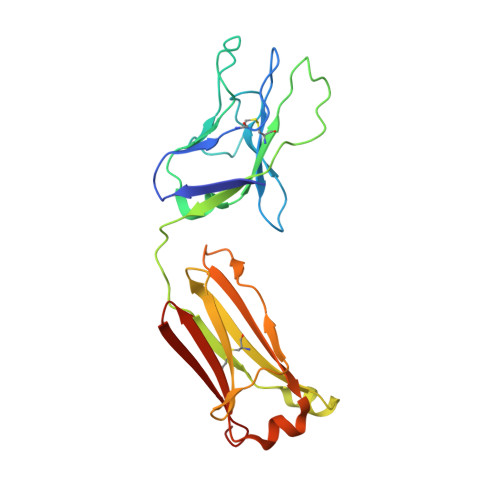Molecular Basis of Unusually High Neutralization Resistance in Tier 3 HIV-1 Strain 253-11.
Moyo, T., Ereno-Orbea, J., Jacob, R.A., Pavillet, C.E., Kariuki, S.M., Tangie, E.N., Julien, J.P., Dorfman, J.R.(2018) J Virol 92
- PubMed: 29618644
- DOI: https://doi.org/10.1128/JVI.02261-17
- Primary Citation of Related Structures:
6CCB - PubMed Abstract:
Understanding the mechanisms used by HIV-1 to evade antibody neutralization may contribute to the design of a high-coverage vaccine. The tier 3 virus 253-11 is poorly neutralized by subtype-matched and subtype C sera, even compared to other tier 3 viruses, and is also recognized poorly by V3/glycan-targeting monoclonal antibodies (MAbs). We found that sequence polymorphisms in the V3 loop and N-linked glycosylation sites contribute only minimally to the high neutralization resistance of 253-11. Interestingly, the 253-11 membrane-proximal external region (MPER) is rarely recognized by sera in the context of the wild-type virus but is commonly recognized in the context of an HIV-2 chimera, suggesting steric or kinetic hindrance of binding to MPER in the native envelope (Env). Mutations in the 253-11 MPER, which were previously reported to increase the lifetime of the prefusion Env conformation, affected the resistance of 253-11 to antibodies targeting various epitopes on HIV-1 Env, presumably destabilizing its otherwise stable, closed trimer structure. To gain insight into the structure of 253-11, we constructed and crystallized a recombinant 253-11 SOSIP trimer. The resulting structure revealed that the heptad repeat helices in gp41 are drawn in close proximity to the trimer axis and that gp120 protomers also showed a relatively compact disposition around the trimer axis. These observations give substantial insight into the molecular features of an envelope spike from a tier 3 virus and into possible mechanisms that may contribute to its unusually high neutralization resistance. IMPORTANCE HIV-1 isolates that are highly resistant to broadly neutralizing antibodies could limit the efficacy of an antibody-based vaccine. We studied 253-11, which is highly resistant to commonly elicited neutralizing antibodies. To further understand its resistance, we made mutations that are known to delay fusion and thus increase the time that the virus spends in the open conformation following CD4 binding. Interestingly, we found that these mutations affect the 253-11 envelope (Env) spike before CD4 binding, presumably by destabilizing the trimer structure. To gain further information about the structure of the 253-11 Env trimer, we generated a recombinant 253-11 SOSIP trimer. The crystal structure of the SOSIP trimer revealed that the gp41 helices and the gp120 protomers were drawn in toward the center of the molecule compared to most solved HIV-1 Env structures. These observations provide insight into the distinct molecular features of a tier 3 envelope spike.
- Division of Immunology, Department of Pathology, University of Cape Town, Cape Town, South Africa.
Organizational Affiliation:
























